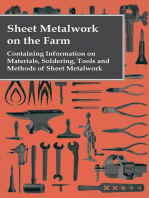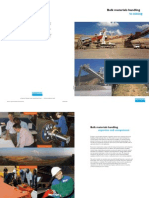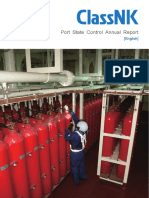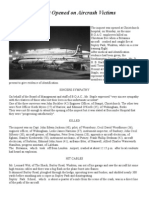Foundry Production Workers: Foundry Production Workers ('Found-Ry Pro'duc-Tion 'Work-Ers) Make Metal
Foundry Production Workers: Foundry Production Workers ('Found-Ry Pro'duc-Tion 'Work-Ers) Make Metal
Uploaded by
Vignesh SpCopyright:
Available Formats
Foundry Production Workers: Foundry Production Workers ('Found-Ry Pro'duc-Tion 'Work-Ers) Make Metal
Foundry Production Workers: Foundry Production Workers ('Found-Ry Pro'duc-Tion 'Work-Ers) Make Metal
Uploaded by
Vignesh SpOriginal Title
Copyright
Available Formats
Share this document
Did you find this document useful?
Is this content inappropriate?
Copyright:
Available Formats
Foundry Production Workers: Foundry Production Workers ('Found-Ry Pro'duc-Tion 'Work-Ers) Make Metal
Foundry Production Workers: Foundry Production Workers ('Found-Ry Pro'duc-Tion 'Work-Ers) Make Metal
Uploaded by
Vignesh SpCopyright:
Available Formats
Brief 374 Chronicle Guidance Publications
Foundry Production Workers
Occupational Brief Title Codes:
D.O.T.: 519.687-022 G.O.E.: 06.04.32 S.O.C.: 51O*NETTM: 51N.A.I.C.S.: 3315 H.O.C.: No Code
Occupational Subtitles:
Casting Inspectors Coremakers Grinder-Chippers Machine Molders Melters Molders Patternmakers
Work Classification Based Related D.O.T. Occupations:
Flux-Tube Attendants Hardness Testers Kettle Operators Manometer Technicians
Interests Based Related G.O.E. Occupations:
Candlemakers Cement Fittings Makers Plastic-joint Makers Terrazo-Tile Makers
Foundry production workers (`found-ry pro`duc-tion `work-ers) make metal castings or parts by heating hard metal until it becomes a red-hot liquid; pouring the liquid (molten) metal into molds; and allowing the metal to cool and turn solid. Foundries are manufacturers who make castings. Castings are metal components that form the basic parts of all kinds of products. Castings include automobile engine blocks, bathtubs, sewer pipes, machine bearings, aircraft and missile parts, railroad car wheels, construction machinery, golf clubs, farm implements, and thousands of other things. In fact, nearly every manufactured product needs metal castings. Castings are made of many different metals or alloys of those metals. Foundries make castings either of ferrous (iron and steel) or nonferrous (non-iron and steel) alloys. Ferrous alloys include steel, malleable iron, ductile iron, and gray iron. Some nonferrous alloys include brass, bronze, aluminum, magnesium, titanium, and zinc. The behavior of molten metal is somewhat erratic because each metal and alloy cast has its own characteristics which affect molding techniques. For this reason, most foundries and foundry workers specialize in either steel, iron, bronze, brass, or aluminum. Foundries are also either production foundries or jobbing foundries. Production foundries make large numbers of castings all alike, and often use machines. Many production foundries are a part of large plants such as those that make autos, farm machinery, or plumbing equipment. Jobbing foundries make castings in different shapes and sizes for many different customers who need special parts. Jobbing foundries (or shops) use more handwork than production foundries. Most jobbing foundries are independent companies who sell their castings to other firms. Work Performed Foundry workers may shape metal castings with machines or by hand. Most foundries use a combination of both traditional techniques along with industrial
Skills Based Related O*NET Occupations:
Forging Machine Setters, Operators, and Tenders, Metal and Plastic Soldering and Brazing Machine Operators and Tenders Tool and Die Makers
Foundry workers may shape metal castings with machines or by hand. 2006 Chronicle Guidance Publications, Inc., Moravia, NY 13118 Printed in United States of America, March 2006 Visit our Web Site www.ChronicleGuidance.com
Photo by CGP Staff
machinery, computer applications, robotics, laser measuring and cutting tools, and other manufacturing technologies. More than half of U.S. castings are produced using sand casting methods, followed by permanent mold, die casting, and investment casting. Although these methods differ in techniques, all require several main elements in their processing of castings: patterns; molds; cores; melting; pouring; cooling; and finishing. The pattern is the original template from which the mold is prepared. Molds are used to create the shape of the castings, and cores are used to produce tunnels or holes in the finished mold. Metal is melted down to a liquid and poured into the molds. Once the metal cools to a solid, the metal castings are removed from the molds; any rough surfaces are ground with a pneumatic hammer or abrasive wheel; and then inspected for proper formation. To begin the process, patternmakers make wood or metal patterns (templates) for the production of castings. They may also work with plaster, epoxy, fiberglass, and plastic. They create the patterns from blueprints and design specifications of the final castings, provided by an engineer or designer, using computer-aided design (CAD/CAM) systems. They then lay-out and mark the design for each section on pieces of wood or metal. Patternmakers use machine tools and power tools, as well as hand tools, to cut and shape the pieces of the pattern. They assemble the pattern pieces and fasten them together with nails, screws, bolts, or glue. They verify the dimensions of the finished pattern and give it a protective coating. This pattern is the size and shape of the final casting for the mold. Patternmakers also employ rapid prototyping technologies, such as laminated object manufacturing (LOM). Skilled molders can make many kinds of molds. They read or use blueprints, drawings, scales, rules, and gauges. To make a sand mold, molders place the pattern in the lower half of a two-piece box called a flask. Molders use ramming tools or a pneumatic rammer to ram or pack a mixture of sand, clay, and water around the pattern. They repeat the process for the top half of the pattern and the flask. After separating the two halves of the flask, molders take the pattern out of the packed sand. This leaves a hole or cavity in the sand, which has the same shape as the pattern. Molders check the shaped outlines of the sand mold. They may use a small trowel and other hand tools to smooth or touch up the surfaces. They then cut holes or channels in the sand to let the molten metal flow into the mold. They also cut other holes to let the gases escape. Molders may then finish a mold by putting a mold-coating substance on the mold surface to make it smooth and to keep the sand from sticking to the hot metal. Molders may make molds by hand or by machine. Hand molders work mainly in jobbing foundries, which fill special job orders. Machine molders work in both production and jobbing foundries, tending machines that produce large numbers of sand molds all alike. Machine molders start by putting patterns in the molding boxes. They fill the boxes with sand and use levers and pedals to run the molding machines. The machines do different jobs such as jolting, squeezing, blowing, rollover, and slinging. Sometimes machine molders
set up their own machines, and may do special molding jobs. Most machine molders, however, are semi-skilled workers who tend the machines others set up for them. If a mold requires a core (a hard, shaped form within a mold that forms an inner cavity in the casting), molders also put it in place. The mold is now ready for the molten metal that will harden into a casting. Coremakers prepare the sand cores that go in molds to form cavities or holes in the finished metal castings. To make cores, they pack sand mixed with oil in hollow forms (core boxes). Skilled workers prepare large or intricate cores. Less-skilled coremakers generally make smaller, simpler cores, but often in large numbers. Machine coremakers run machines that force sand into core boxes. Some of these workers also set up and adjust their own machines to do the finishing work on the cores. Melters, sometimes called melt technicians, tend furnaces that melt metal for castings. Many work with one kind of furnace (cupola, electric arc, or induction, for instance) but with one or more alloys. Skilled melters charge (load) furnaces, control temperatures and melting times, and decide when the metal is ready to pour. Pourers then pour the molten metal into the molds, or operate machines that pour and inject the molten metal into the molds. Once the metal cools to a solid, shake-out workers take the castings from the molds. Machines can also do some of this work. Shotblasters, sandblasters, and tumbler operators then clean the burned-on sand from castings. Finishers weld, press, drill, and straighten the castings as needed; and annealers tend furnaces that heat and cool the castings to relieve stresses from the initial cooling, and to make them stronger and less brittle. In the case of steel or iron, castings may be quenched in water or oil. Grinder-Chippers, many of whom are unskilled workers, clean and finish parts. Grinders use abrasive wheels to smooth and finish the castings. Chippers use power hammers or hand hammers and chisels to remove chips and the burrs from castings. Both also use computer guided machine technologies, like computer numericalcontrolled (CNC) programs. In many foundries these two jobs are often combined. The skills required vary with the intricacy of the castings, the precision required, and the amount of supervision workers need. These workers may also do an initial inspection of the castings. Casting inspectors check the castings for soundness and dimensions. They read blueprints, analyze defects, and suggest ways to correct them. The extent of inspections on castings varies with the requirements of the customers. Many inspectors do routine checks on large numbers of castings all alike. Other inspectors examine in detail selected samples of special castings. In recent years technological advancements have changed many of the traditional methods used in foundries. For example, other methods of casting such as no-bake and investment casting offer customers different options with regard to casting performance or appearance. One of the newest methods is the lost foam process, which uses sand
but does not require binders in the process. Many of the automotive foundries use this lost foam process. Working Conditions Most foundries have ventilation systems and air-conditioning, but can still be noisy, dirty, and hot. Pattern shops operate either as part of a foundry or as an independent operation producing patterns for different foundries. In either case, patternmakers generally enjoy pleasant working conditions, but are subject to the noise of wood and metal working machines. Most tasks require standing, stooping, lifting, and carrying, which can be strenuous. The injury rate in foundries tends to be higher than that of some other industries, but safety measures have cut this rate significantly in recent years. Most foundries today have safety programs, and workers wear safety glasses, steel-toed shoes, ear protectors, and other safety equipment. Hours and Earnings Foundry workers generally have a forty hour workweek, but overtime is common. Some foundries may have two or three shifts. Overtime work may also include evenings and weekends. Some foundry workers get paid by the number of pieces they produce, but most are paid an hourly wage. In general, earnings vary with the kind of foundry in which the workers are employed. According to the Bureau of Labor Statistics, foundry production workers in iron foundries averaged $20.01 an hour in 2004. Those in steel foundries averaged $15.46 an hour; and workers in nonferrous metal foundries averaged $14.71 an hour. Earnings also vary with experience and responsibilities. Wages for dangerous or hazardous jobs, for instance, may be somewhat higher. Apprentices and trainees may start at minimum wage; and night crews are usually paid a shift differential. Almost all foundries have life and health insurance plans and retirement plans for their workers. Most workers get two weeks of paid vacation a year after one to five years of employment. Foundry workers also get about eleven paid holidays a year. Education and Training Some foundry workers start as helpers in unskilled jobs and learn from skilled workers or supervisors. Most workers, however, serve an apprenticeship. Employers prefer to hire workers with a high school diploma or a GED, and a background in science, mathematics, shop courses, mechanical drawing, and industrial engineering or business. Since the metal castings industry is becoming more technical, foundry workers should have some knowledge of computers, computer-aided design applications, mechanics, drafting, and mathematics. Postsecondary and technical trade school courses may prove useful to foundry workers as well. Course work should cover metallurgy, and industrial, mechanical, and materials manufacturing and engineering technologies.
Additional job shadowing or co-operative experiences are also highly recommended. However, many professionals feel such programs of study cannot replace an apprenticeship. To enter an apprenticeship program, candidates must be at least 18 years old and employable by a foundry. Most apprentices start as helpers. They start with simple tasks and gradually learn more difficult jobs. Apprentices also receive at least 144 hours a year of instruction in subjects such as shop math, metallurgy, and shop drawing. Molders and coremakers generally must complete a three- to four-year apprenticeship, or its equivalent, to attain full journey-level statussometimes in a combined program. They learn to ram molds, remove patterns, set cores, and how to operate molding machines. Patternmakers may serve a five-year apprenticeship. Melters may learn some melting jobs in informal training. They begin as furnace helpers. Skilled melters must have a broad knowledge of foundry work, shop mathematics, and certain processes dealing with chemistry and metallurgy. Grinder-Chippers also learn their work on the job. Most castings inspectors are experienced foundry workers. Many are former chippers and grinders, finishers, or workers promoted from other cleaning tasks. When workers are trained on the job, the length of training depends on the complexity of the job. Those who work on intricate castings need considerable experience. The chances for advancement are also better for those who continue their education. The Cast Metals Institute of the American Foundry Society sponsors training on all subjects pertaining to the castings industry. The program offers courses such as process metallurgy-ferrous and process metallurgy-nonferrous, sand technology, core technology, and advanced general foundry technology. Certification, Unions and Professional Societies Some foundries, especially smaller shops, are nonunion. However, some foundry production workers may belong to the Glass, Molders, Pottery, Plastics, and Allied Workers International Union, or United Steelworkers of America. The American Foundry Society (AFS) is the leading technical and trade association concerned with the castings industry. AFS has over 13,000 members throughout its many local, state, and student chapters. The Cast Metals Institute is the educational arm of this group, offering a variety of educational and certification opportunities within the castings industry. The Foundry Educational Foundation (FEF) is the cast metals industrys educational program at the college level. Among other foundry trade associations are the Steel Founders Society of America (SFSA), the Non-Ferrous Founders Society (NFFS), the Investment Casting Institute (ICI), and the Ductile Iron Society (DIS). Personal Qualifications Requirements for foundry workers vary with the job, the castings, and the equipment they use. In general, all foundry workers should be able to follow instructions closely, and they should enjoy working with tools and metals. Attention to detail, alertness, and a strong work ethic are required to ensure
quality work. Teamwork and the ability to learn on the job are important. Most positions also require good health with no respiratory, heart, or back problems; average physical strength; good hand-eye coordination; and good manual dexterity. Occupations can be adapted for workers with disabilities. Persons should contact their school or employment counselors, their state office of vocational rehabilitation, or their state department of labor to explore fully their individual needs and requirements as well as the requirements of the occupation. Where Employed According to the Bureau of Labor Statistics, foundries employed roughly 165,000 workers in all in 2004132,000 of which were production workers. There are an estimated 2,950 foundries in the United States. Each foundry may employ fewer than fifty workers or more than 250. Most foundries are near large industries that need castings. Foundries also operate near the source of basic supplies such as pig iron, coke, ferrous scrap, and nonferrous ingot. Every state has some foundries, but most foundry jobs are in industrial states in the Midwest, the Northeast, and on the Pacific Coast. States leading in the number of castings produced are Ohio, Indiana, Wisconsin, Alabama, Michigan, Illinois, Pennsylvania, Tennessee, California, and Texas. Employment Outlook The Bureau of Labor Statistics expects employment of foundry workers to grow by 11 percent through the year 2012an increase of roughly 20,000 positions. Many additional jobs will also open due to replacement needs. There has been an overall increase in demand for castings by end-use markets (industries that use castings in the manufacture of their products). This rebound of the foundry industry from several years of economic recession is expected to continue. Many foundries, however, are using more sophisticated computer systems and complex mechanization. These and other technical advances in foundry methods are reducing the need for some skills and some workers. The continued trend toward automation, in particular, is reducing the demand for some unskilled workers. Although individuals with a high school diploma will find work, those with education beyond high school will have the best prospects. Entry Methods Beginners should apply for work at local foundries or at the foundry departments of metal products industries. They may get jobs as laborers or helpers and then learn skilled work. High school graduates may apply for jobs or for an apprenticeship. Information about employment and apprenticeships is available at state employment offices and the local chapter of the appropriate union representing these workers. Other sources for job leads include private employment agencies, temporary employment agencies, and help wanted ads.
Advancement Some skilled and experienced workers may advance to supervisory work. They may become lead workers, production supervisors, department heads, technical advisors, cost estimators, or designers. An apprenticeship, formal study, and years of service may help these workers advance to plant supervisor, union leadership positions, or management. Mobility between employers may be limited, however, because many employers require new employees to start at entry-level positions. For Further Research American Foundry Society, 1695 North Penny Lane, Schaumburg, IL 60173-4555. Web site: www.afsinc.org Foundry Educational Foundation, 1695 North Penny Lane, Schaumburg, IL 60173-4555. Web site: www.fefoffice.org Acknowledgments Chronicle Guidance Publications appreciates the cooperation of the individuals who reviewed the information in this brief.
O*NETTM is a trademark of the U.S. Department of Labor, Employment and Training Administration. H.O.C. codes adapted and reproduced by special permission of the publisher, Psychological Assessment Resources, Inc., Odessa, FL 33556, from the Dictionary of Holland Occupational Codes-Third Edition, by Gary D. Gottfredson, Ph.D., and John L. Holland, Ph.D. Copyright 1982, 1989, 1996 by PAR, Inc.
Briefs Related to This Title Computer Numerical-Control Machine Operators. Brief 556. Electroplaters. Brief 398. Forge Shop Workers. Brief 352. Iron and Steel Industry Workers. Brief 305. Machinists. Brief 32. Materials Engineers. Brief 256. Metallurgists. Brief 62. Ornamental Blacksmiths. Brief 588. Scrap Metal Processing Workers. Brief 253. Tool and Die Makers. Brief 60. For a complete list of brief and reprint titles with current pricing information call: Chronicle Guidance Publications, Inc. 66 Aurora Street Moravia, New York 13118-3569 Phone 1 800 622-7284 FAX (315) 497-3359 Visit our Web Site at www.ChronicleGuidance.com
Occupations discussed or illustrated should be considered valid for all persons regardless of disabilities, age, sex, or race.
You might also like
- Snapdeal: A Nightmare or A Benefit in Reverse Logistics?Document9 pagesSnapdeal: A Nightmare or A Benefit in Reverse Logistics?Vamsee Krishna Vyas BNo ratings yet
- Introduction 1.. FoundryDocument112 pagesIntroduction 1.. FoundryDhananjay Shimpi100% (1)
- Brazing - Fundamentals - 1Document7 pagesBrazing - Fundamentals - 1Sadashiw PatilNo ratings yet
- Sample Quality PlanDocument17 pagesSample Quality PlanKhaled Abdelbaki100% (2)
- Casting Its TypesDocument84 pagesCasting Its Typesanmanjunath086No ratings yet
- Castingitstypes 140222031231 Phpapp02Document85 pagesCastingitstypes 140222031231 Phpapp02Harmain Ahmed CMNo ratings yet
- Wikipedia - FoundaryDocument7 pagesWikipedia - Foundaryshovit singh100% (1)
- Foundary OverviewDocument8 pagesFoundary OverviewPradeep Pandurang JadhavNo ratings yet
- ME6352 Manufacturing Technolgy: Unit I Casting 8Document54 pagesME6352 Manufacturing Technolgy: Unit I Casting 8Aravind PhoenixNo ratings yet
- Foundery Shop (Ch-6)Document121 pagesFoundery Shop (Ch-6)Shubham VermaNo ratings yet
- Summer Training Report CastingDocument29 pagesSummer Training Report CastingFaisal Bin Shabbir100% (1)
- Casting IntroductionDocument14 pagesCasting Introductionaakash bhardwajNo ratings yet
- Permanent Mold CastingDocument9 pagesPermanent Mold CastingBrown MeshNo ratings yet
- Unit - 1 Metal Casting Processes-NVRDocument287 pagesUnit - 1 Metal Casting Processes-NVRPrashon GNo ratings yet
- Production TechnologyDocument60 pagesProduction Technology2mohan7100% (2)
- Metal Fabrication - WikipediaDocument4 pagesMetal Fabrication - WikipediaSanthan SalaiNo ratings yet
- Differences Between Metal Forming Process and Casting ProcessDocument21 pagesDifferences Between Metal Forming Process and Casting ProcessFarhana Eyla75% (4)
- Metal Fabrication Is The Building of Metal Structures by CuttingDocument4 pagesMetal Fabrication Is The Building of Metal Structures by Cuttingdiyanto AntoNo ratings yet
- BME B Project Armaan SinghDocument16 pagesBME B Project Armaan Singharmaansingh 2K20B1220No ratings yet
- Process of Sand CastingDocument5 pagesProcess of Sand CastingHailu BeyechaNo ratings yet
- Metal FabricationDocument5 pagesMetal FabricationJustin ThomasNo ratings yet
- Metal CastingDocument40 pagesMetal CastingFahmi Sanji AlexanderNo ratings yet
- Foundry ReportDocument7 pagesFoundry Reportmcdonald juma0% (1)
- Bayero University Kano: Manufacturing Processes Lab Report Group D 19/03/2021Document14 pagesBayero University Kano: Manufacturing Processes Lab Report Group D 19/03/2021mukhtar bashir mustaphaNo ratings yet
- MT Merged PDFDocument273 pagesMT Merged PDFavcNo ratings yet
- BCMEDocument35 pagesBCMErupanandaNo ratings yet
- Casting Manufacturing Lab ReportDocument16 pagesCasting Manufacturing Lab ReportNiko KoNo ratings yet
- Manufacturing Engineering Blueprint ObjectivesDocument24 pagesManufacturing Engineering Blueprint Objectiveskidusabeje7No ratings yet
- SWEPDocument11 pagesSWEPRizzleNo ratings yet
- Sand Casting: Over 70% of All Metal Castings Are Produced Via A Sand Casting ProcessDocument45 pagesSand Casting: Over 70% of All Metal Castings Are Produced Via A Sand Casting ProcessSUNDRAMNAGANo ratings yet
- Unit 1 NotesDocument27 pagesUnit 1 NotesarunkumarnoolaNo ratings yet
- Chapter 3 CastingDocument35 pagesChapter 3 CastingShalin SharmaNo ratings yet
- Lec 1 & 2Document43 pagesLec 1 & 2Omar AssalNo ratings yet
- BCM 2Document34 pagesBCM 2rupanandaNo ratings yet
- Assignment No # 1: Topic: Subject: Session: Submitted By: Roll NoDocument22 pagesAssignment No # 1: Topic: Subject: Session: Submitted By: Roll NoLvlNo ratings yet
- Die Casting: Metal Casting Molten Metal Mold Cavity Tool SteelDocument11 pagesDie Casting: Metal Casting Molten Metal Mold Cavity Tool SteelabhivpcoeNo ratings yet
- Fundamentals of Manufacturing and Process Report (Group - 4)Document6 pagesFundamentals of Manufacturing and Process Report (Group - 4)Lovely VisakhaNo ratings yet
- Subject Code: Me6302 Manufacturing Technology 1Document117 pagesSubject Code: Me6302 Manufacturing Technology 1amdevaNo ratings yet
- Casting LabDocument11 pagesCasting Labfawad naeemNo ratings yet
- Lecture NotesDocument74 pagesLecture Notesasisha mostNo ratings yet
- Overviews: Estimators Parts Widgets Processes Materials Suppliers NewsDocument113 pagesOverviews: Estimators Parts Widgets Processes Materials Suppliers Newsrupesh89890% (1)
- Department of Industrial & Production Engineering BUET, Dhaka-1000Document25 pagesDepartment of Industrial & Production Engineering BUET, Dhaka-1000Anshul ShuklaNo ratings yet
- Mp1 m1 Short NotesDocument43 pagesMp1 m1 Short NotesRadhika GandhiNo ratings yet
- Unit 1 Metal Casting ProcessesDocument115 pagesUnit 1 Metal Casting ProcessesMadhav MaheshwariNo ratings yet
- Overview of Casting TechnologyDocument5 pagesOverview of Casting TechnologySK Kushwah RajputNo ratings yet
- Casting Processes and ApplicationsDocument17 pagesCasting Processes and ApplicationsMadushanNo ratings yet
- CastingDocument7 pagesCastingRefat Bin SultanNo ratings yet
- Dr. Babasaheb Ambedkar Technological University, LonereDocument36 pagesDr. Babasaheb Ambedkar Technological University, LonereNikhil PawarNo ratings yet
- Manufacturing Summaries: Expendable Mold and Permanent MoldDocument4 pagesManufacturing Summaries: Expendable Mold and Permanent MoldSanguinius28No ratings yet
- Topic 4 - Metal CastingDocument31 pagesTopic 4 - Metal CastingKelvin KVNo ratings yet
- It Is ConsiderationDocument17 pagesIt Is ConsiderationTulasabai JaiswalNo ratings yet
- Eme Unit-4Document51 pagesEme Unit-4Shiva DattiNo ratings yet
- Metal Stamping and Fabricating OperationsDocument23 pagesMetal Stamping and Fabricating OperationsAnonymous wtK1AZBi100% (1)
- Manufacturing Technology AnswersDocument32 pagesManufacturing Technology AnswersDaRkSouLNo ratings yet
- Foundry Asguest57564 Download: Share Add To Flagembed Views: 5846 Category: EducationDocument9 pagesFoundry Asguest57564 Download: Share Add To Flagembed Views: 5846 Category: EducationGurjinder SinghNo ratings yet
- Sand Casting OverviewDocument166 pagesSand Casting Overviewsamurai7_77100% (1)
- MP 1st Module NotesDocument39 pagesMP 1st Module NotesKailas Sree ChandranNo ratings yet
- Learn Critical Aspects of Pattern and Mould Making in FoundryFrom EverandLearn Critical Aspects of Pattern and Mould Making in FoundryNo ratings yet
- Home Instruction for Sheet Metal Workers - Based on a Series of Articles Originally Published in 'Metal Worker, Plumber and Steam Fitter'From EverandHome Instruction for Sheet Metal Workers - Based on a Series of Articles Originally Published in 'Metal Worker, Plumber and Steam Fitter'No ratings yet
- Sheet Metalwork on the Farm - Containing Information on Materials, Soldering, Tools and Methods of Sheet MetalworkFrom EverandSheet Metalwork on the Farm - Containing Information on Materials, Soldering, Tools and Methods of Sheet MetalworkNo ratings yet
- Tool-Steel - A Concise Handbook on Tool-Steel in General - Its Treatment in the Operations of Forging, Annealing, Hardening, Tempering and the Appliances ThereforFrom EverandTool-Steel - A Concise Handbook on Tool-Steel in General - Its Treatment in the Operations of Forging, Annealing, Hardening, Tempering and the Appliances ThereforNo ratings yet
- A Practical Workshop Companion for Tin, Sheet Iron, and Copper Plate Workers: Containing Rules for Describing Various Kinds of Patterns used by Tin, Sheet Iron, and Copper Plate Workers, Practical Geometry, Mensuration of Surfaces and Solids, Tables of the Weights of Metals, Lead Pipe, Tables of Areas and CircumferencesFrom EverandA Practical Workshop Companion for Tin, Sheet Iron, and Copper Plate Workers: Containing Rules for Describing Various Kinds of Patterns used by Tin, Sheet Iron, and Copper Plate Workers, Practical Geometry, Mensuration of Surfaces and Solids, Tables of the Weights of Metals, Lead Pipe, Tables of Areas and CircumferencesNo ratings yet
- Go1 Insurance Assigned CasesDocument9 pagesGo1 Insurance Assigned CasesWendell Leigh OasanNo ratings yet
- D2F F14Document20 pagesD2F F14Emy JacobNo ratings yet
- Melin Catalog 2005Document122 pagesMelin Catalog 2005Sujata KulkarniNo ratings yet
- DHL & Its E-BusinessDocument15 pagesDHL & Its E-BusinessNivedita Sharma100% (1)
- Ies Inv MGMTDocument59 pagesIes Inv MGMTDarshana ShahNo ratings yet
- Piping Codes / StandardsDocument27 pagesPiping Codes / Standardsviahul100% (1)
- 381GB Dachsys2000 0907 PDFDocument16 pages381GB Dachsys2000 0907 PDFVas SteelNo ratings yet
- BMH in Mining WebDocument10 pagesBMH in Mining WebJavier Auccatoma Beramendi100% (1)
- RTC Logistics PVT - LTDDocument3 pagesRTC Logistics PVT - LTDAnoop KalathillNo ratings yet
- Introduction of Quality TextileDocument11 pagesIntroduction of Quality TextileSaad JavedNo ratings yet
- Storeman DetailsDocument2 pagesStoreman DetailsPaul SimonNo ratings yet
- FpsoDocument8 pagesFpsoJorge HL0% (2)
- Document For ExportingDocument2 pagesDocument For ExportingLijofrancisNo ratings yet
- NY Supplier Quality Requirements and InstructionsDocument9 pagesNY Supplier Quality Requirements and InstructionspacifficNo ratings yet
- NAK80 MaterialDocument3 pagesNAK80 MaterialRicky Indra DjunawanNo ratings yet
- II Pipeline Design Codes and Standards-MSGDocument74 pagesII Pipeline Design Codes and Standards-MSGSanjay Kumar100% (5)
- PSC14EDocument62 pagesPSC14ENguyen Huu TriNo ratings yet
- The Weyburn-Midale ProjectDocument9 pagesThe Weyburn-Midale ProjectPutri SaidatinaNo ratings yet
- 08 JAR-FCL Subpart F - Type and Class RatingsDocument16 pages08 JAR-FCL Subpart F - Type and Class RatingsPaulo AguiarNo ratings yet
- Cash Management Questionnaire AllentownDocument14 pagesCash Management Questionnaire Allentownqkhan2000No ratings yet
- Sindhudurga Aronda JettyDocument2 pagesSindhudurga Aronda JettysawshivNo ratings yet
- ULI Advisory Services Panel Report: A Strategy For Renewing The Union Station District in Los AngelesDocument37 pagesULI Advisory Services Panel Report: A Strategy For Renewing The Union Station District in Los AngelesMetro Los AngelesNo ratings yet
- Nonwoven Fabric - Wikipedia, The Free EncyclopediaDocument5 pagesNonwoven Fabric - Wikipedia, The Free EncyclopediasangareeeNo ratings yet
- Brittania Crash Winkton 1958Document4 pagesBrittania Crash Winkton 1958droshkyNo ratings yet
- Advanced Tactical FighterDocument6 pagesAdvanced Tactical Fightervishnu_sreekumar91No ratings yet
- AOADocument7 pagesAOANitin SaxenaNo ratings yet
- Subsea PipelineDocument1 pageSubsea PipelineHai Ha ChuNo ratings yet

























































































